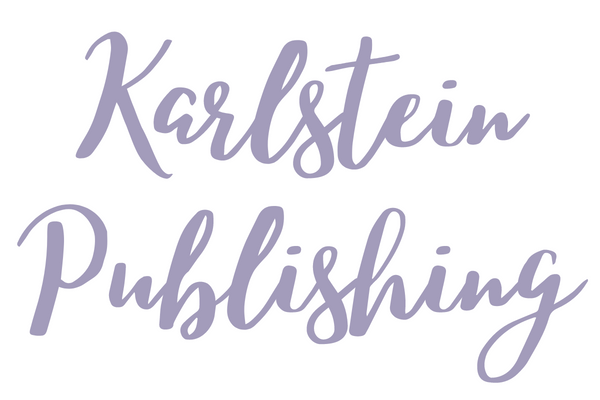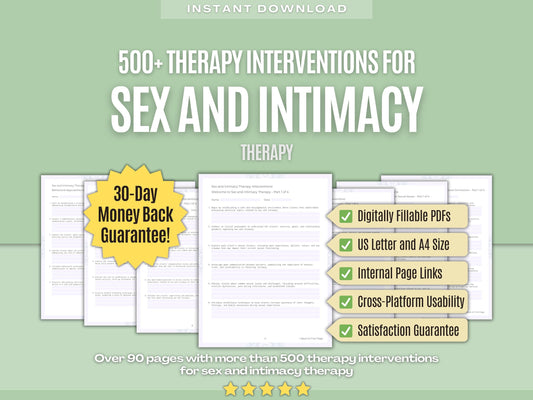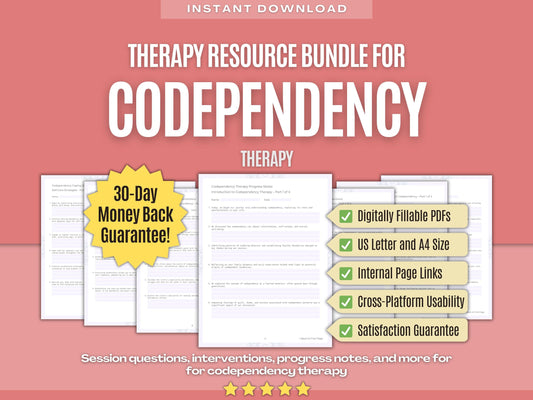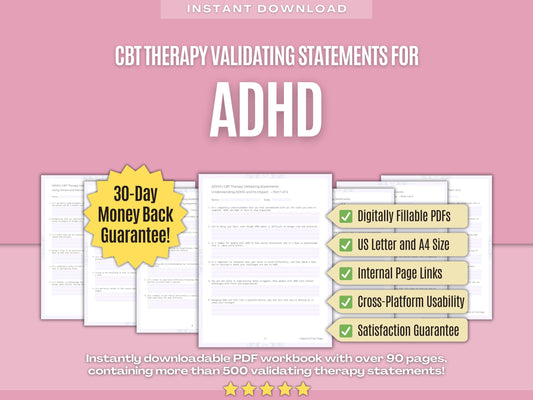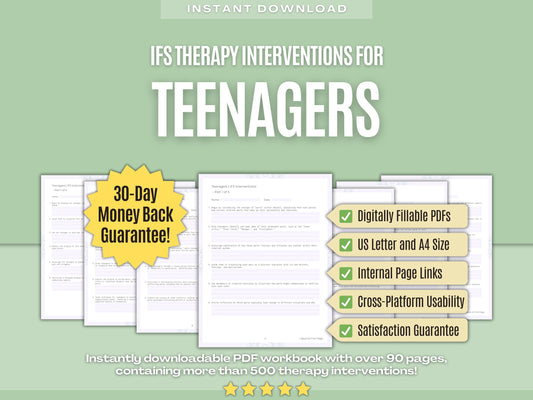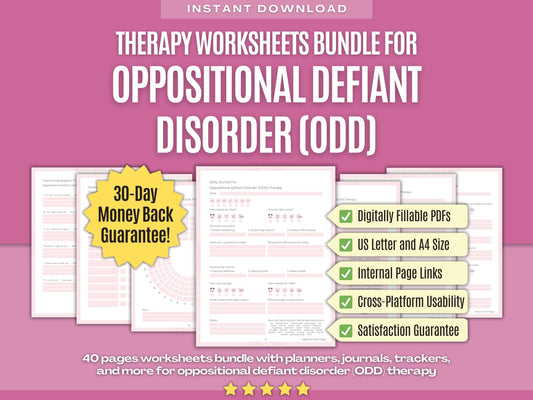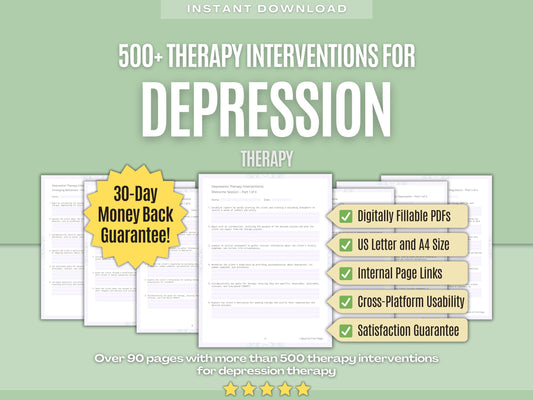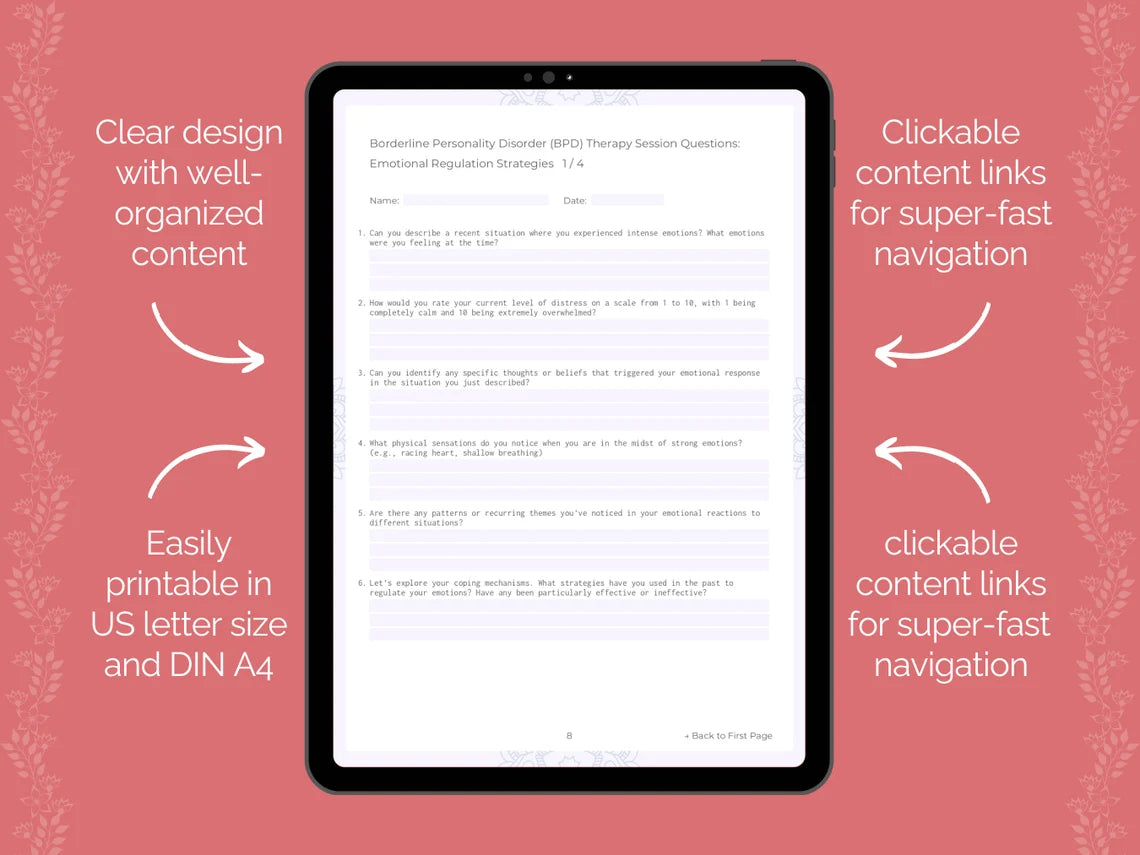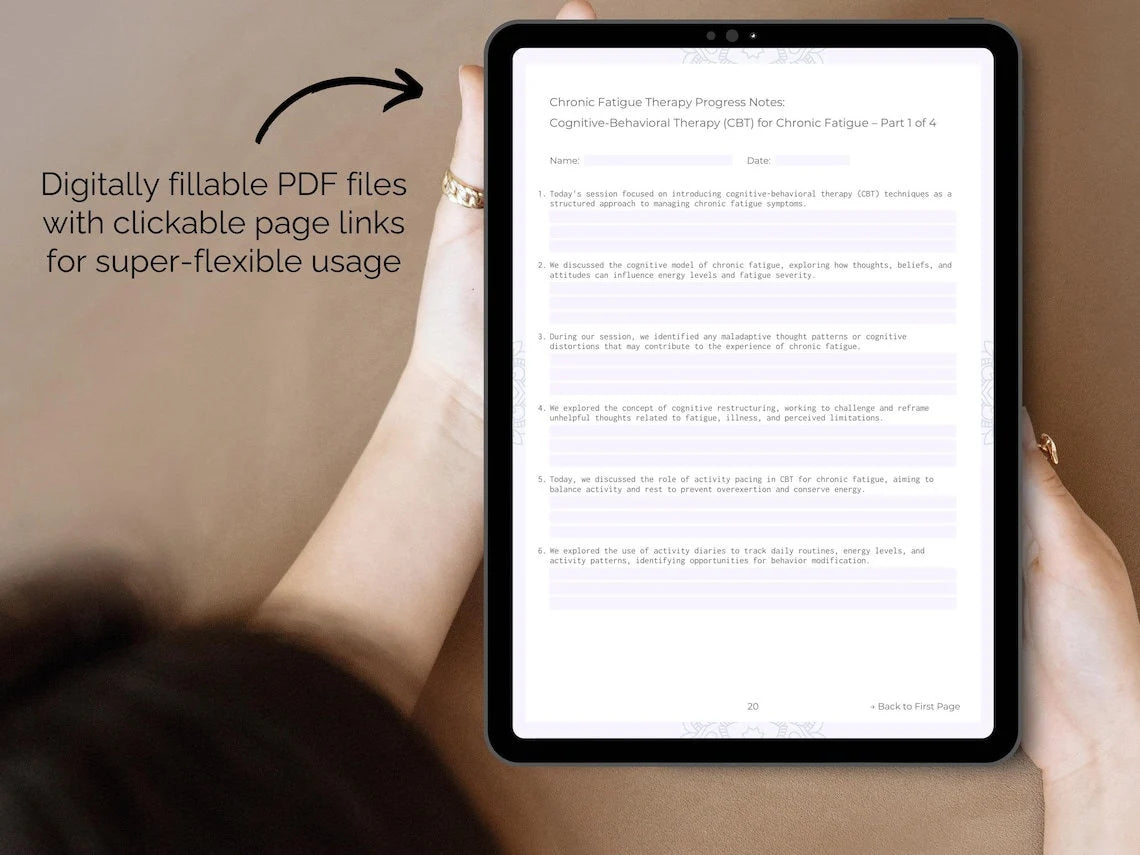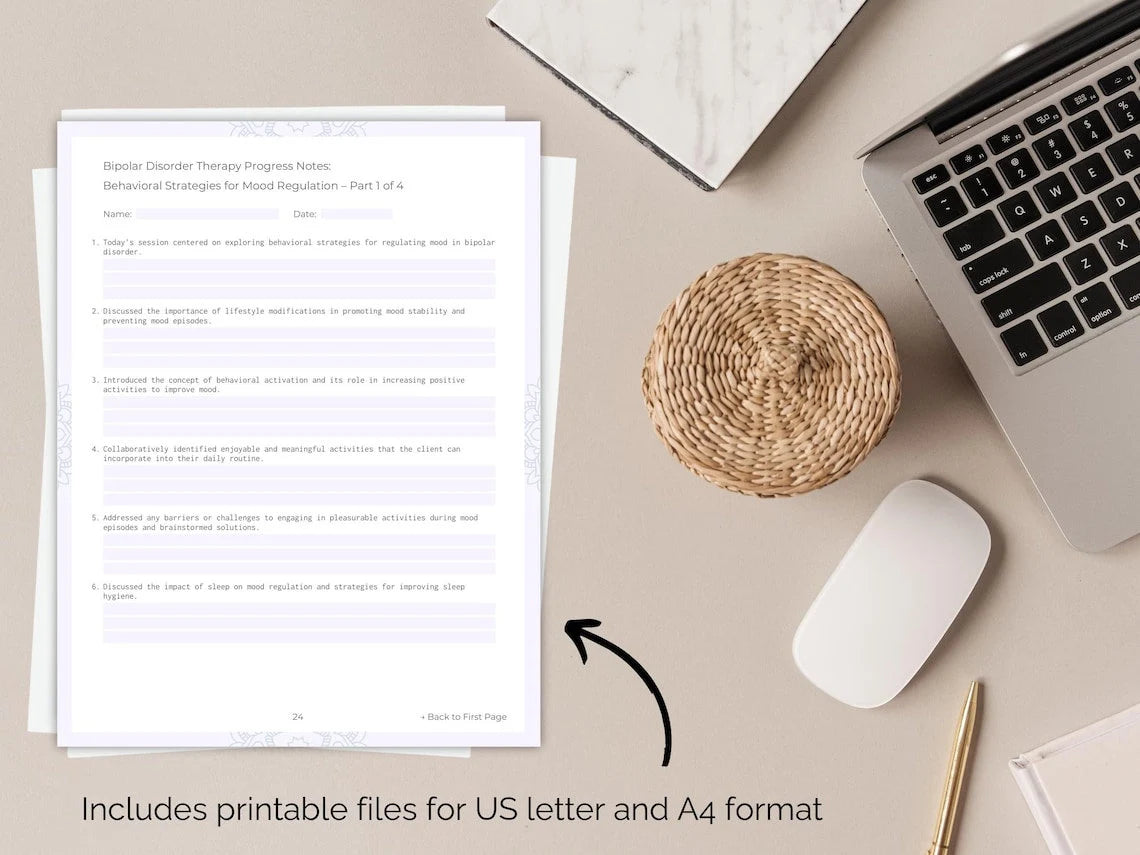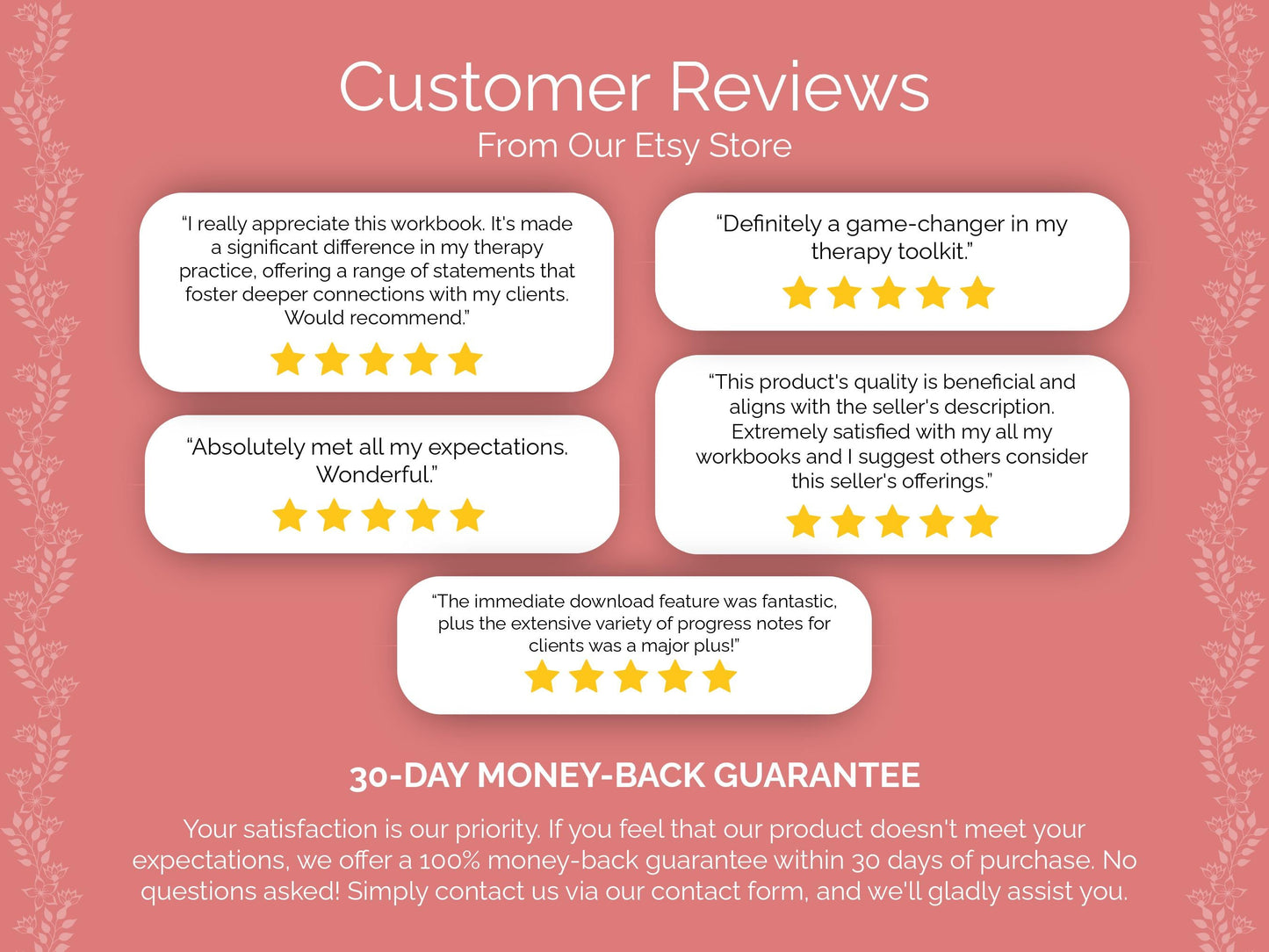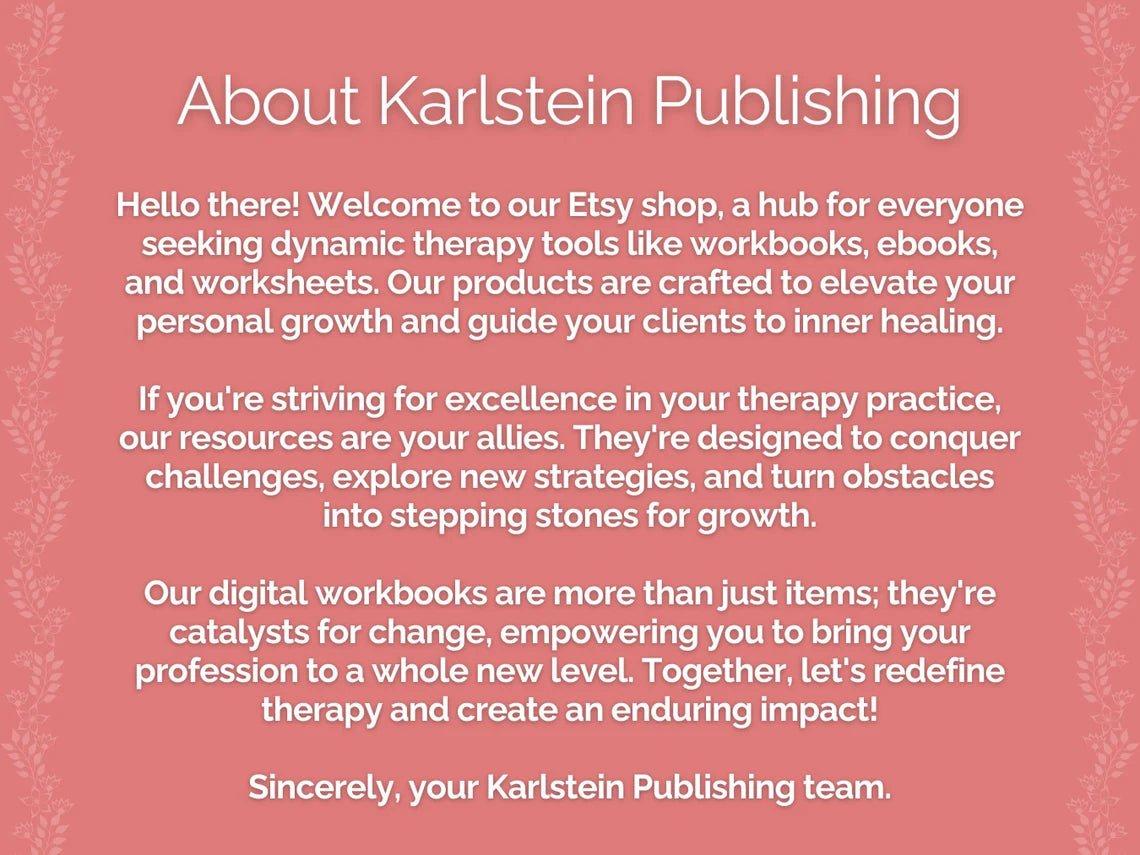Elevate Your Therapy and Guide Your Clients to Inner Healing with Our ADHD Therapy Interventions! ✨
1. Commencing Therapy Sessions
- Begin by establishing a welcoming and nonjudgmental atmosphere to create a sense of safety and trust for the client.
- Collaboratively set an agenda for the session to ensure that both the therapist and client are aligned on the topics to be addressed.
- Use psychoeducation to deepen the client's understanding of ADHD symptoms and how they may manifest in their daily life.
- Explore any recent or ongoing stressors in the client's life and discuss coping strategies to navigate these challenges effectively.
- Discuss strategies for improving time management and organizational skills, tailored to the client's specific needs and preferences.
- Introduce cognitive-behavioral strategies to challenge negative thought patterns and promote more adaptive ways of thinking.
- Explore the client's strengths and areas of interest to identify potential sources of motivation and engagement in therapy.
- Introduce the concept of behavioral activation to help the client increase participation in rewarding activities and enhance mood.
- Explore the client's support network and identify sources of social support that can aid in their therapeutic journey.
- Validate the client's experiences and emotions related to living with ADHD, while also promoting resilience and self-empowerment.
- Introduce strategies for managing impulsivity and improving impulse control in various contexts, such as at work or in relationships.
Need more? Find all 500+ Therapy Interventions for ADHD Therapy in our Digital Workbook!
2. ADHD Psychoeducation
- Begin by providing a comprehensive overview of ADHD, including its definition, prevalence, and neurobiological underpinnings, to lay the foundation for understanding.
- Discuss the developmental trajectory of ADHD, emphasizing that symptoms can persist into adulthood and impact various aspects of life.
- Explore the impact of ADHD on executive functioning skills, such as organization, time management, and task initiation, and how deficits in these areas can affect daily functioning.
- Introduce the concept of neurodiversity and highlight the strengths and talents that individuals with ADHD may possess.
- Discuss the importance of early diagnosis and intervention for ADHD to minimize long-term difficulties and improve outcomes.
- Discuss the social and emotional challenges associated with ADHD, such as difficulty maintaining friendships, managing emotions, and regulating behavior.
- Provide information about different treatment options for ADHD, including medication, therapy, behavioral interventions, and lifestyle modifications.
- Explore the role of therapy in ADHD treatment, including cognitive-behavioral therapy (CBT), psychoeducation, and skills training.
- Discuss the impact of lifestyle factors, such as exercise, nutrition, and sleep, on ADHD symptoms and strategies for optimizing these areas.
- Explore the impact of ADHD on relationships, including communication difficulties, impulsivity, and conflict resolution strategies.
- Validate the experiences of individuals with ADHD and provide empathy and understanding for the unique challenges they may face.
Need more? Find all 500+ Therapy Interventions for ADHD Therapy in our Digital Workbook!
3. Mindfulness-Based Interventions
- Begin by explaining the concept of mindfulness and its relevance to managing ADHD symptoms, emphasizing present-moment awareness and non-judgmental acceptance.
- Teach clients how to incorporate mindfulness into their daily routines by setting aside dedicated time for practice, such as in the morning or before bed.
- Introduce mindfulness-based stress reduction (MBSR) techniques, such as mindful walking or eating, to help clients manage stress and reduce feelings of overwhelm.
- Explore the role of mindfulness in emotion regulation, teaching clients techniques for observing and accepting their emotions without judgment.
- Incorporate mindfulness-based cognitive therapy (MBCT) techniques, such as cognitive defusion and decentering, to help clients disengage from unhelpful thought patterns.
- Discuss the concept of "beginner's mind" and encourage clients to approach each moment with curiosity and openness, free from preconceived notions or expectations.
- Explore the link between mindfulness and self-compassion, teaching clients to cultivate a kind and nurturing attitude towards themselves, especially in moments of difficulty.
- Discuss the benefits of mindfulness for enhancing overall well-being, including reduced stress, improved mood, and greater resilience in the face of challenges.
- Guide clients in setting realistic expectations for their mindfulness practice, emphasizing consistency and gradual progress over perfection.
- Discuss the role of mindfulness in enhancing self-awareness and insight, helping clients gain a deeper understanding of their thoughts, emotions, and behaviors.
- Provide resources and recommendations for further exploration of mindfulness, including books, apps, and online courses.
Need more? Find all 500+ Therapy Interventions for ADHD Therapy in our Digital Workbook!
4. Dialectical Behavior Therapy (DBT)
- Begin by introducing the core principles of dialectical behavior therapy (DBT), including mindfulness, distress tolerance, emotion regulation, and interpersonal effectiveness.
- Explore the concept of distress tolerance and provide clients with coping skills to manage intense emotions and crisis situations without resorting to impulsive or harmful behaviors.
- Introduce interpersonal effectiveness skills to help clients navigate social interactions, set boundaries, and communicate assertively while maintaining self-respect and empathy for others.
- Guide clients in developing a crisis survival plan to manage acute episodes of emotional dysregulation or distress, including strategies for self-soothing, distraction, and seeking support.
- Implement diary cards or mood logs to help clients track their emotions, behaviors, and coping strategies over time, providing valuable data for treatment planning and evaluation.
- Discuss the concept of dialectics and help clients recognize the inherent tensions and contradictions in their thoughts, emotions, and beliefs, promoting flexibility and acceptance of ambiguity.
- Explore the concept of radical acceptance and help clients develop a willingness to tolerate and embrace reality as it is, rather than fighting against it or becoming overwhelmed by it.
- Introduce opposite action as a technique for changing emotional states by acting opposite to the urges driven by intense emotions, such as engaging in activities that evoke feelings contrary to the current emotion.
- Discuss the concept of dialectical abstinence and help clients balance their desire for short-term relief with their long-term goals and values, promoting healthier coping strategies.
- Explore the impact of validation and invalidation in interpersonal relationships, helping clients recognize patterns of communication that contribute to conflict or distress.
- Discuss the importance of building mastery and engaging in activities that promote a sense of competence and accomplishment, even in the face of challenges or setbacks.
Need more? Find all 500+ Therapy Interventions for ADHD Therapy in our Digital Workbook!
5. Interpersonal Therapy (IPT)
- Begin by establishing a collaborative therapeutic relationship with the client, emphasizing empathy, validation, and nonjudgmental acceptance of their experiences.
- Use psychoeducation to help the client understand the connection between ADHD and interpersonal functioning, including common patterns of interaction and areas of vulnerability.
- Explore the client's interpersonal patterns and dynamics, including their relationship history, family dynamics, and current social support network.
- Discuss the impact of ADHD symptoms on the client's relationships, including difficulties with attention, impulsivity, emotional regulation, and executive functioning.
- Address any relationship difficulties or conflicts that may be contributing to the client's distress, using techniques such as active listening, empathy, and validation to facilitate understanding and resolution.
- Discuss the role of social isolation and loneliness in ADHD, and explore ways to help the client build and maintain meaningful social connections and relationships.
- Use role-playing exercises to help the client practice assertive communication skills, such as expressing needs, setting boundaries, and resolving conflicts constructively.
- Discuss the impact of ADHD on romantic relationships, including challenges with communication, intimacy, and emotional regulation, and explore strategies for improving relationship satisfaction.
- Use problem-solving techniques to help the client identify and address interpersonal problems or conflicts, brainstorming solutions and evaluating their effectiveness.
- Discuss the concept of social rhythm disruption and how it may contribute to mood disturbances and interpersonal difficulties in individuals with ADHD, and explore strategies for stabilizing social rhythms.
- Address any cultural factors that may impact the client's interpersonal relationships, including cultural norms, values, and communication styles.
Need more? Find all 500+ Therapy Interventions for ADHD Therapy in our Digital Workbook!
6. Emotion-Focused Therapy (EFT)
- Begin by creating a safe and supportive therapeutic environment where clients feel comfortable exploring and expressing their emotions related to their ADHD symptoms and challenges.
- Explore the underlying emotional needs and vulnerabilities that may be driving maladaptive coping strategies or behaviors related to ADHD, such as procrastination, avoidance, or impulsivity.
- Facilitate emotional processing by encouraging clients to express and explore their emotions in the therapy session through verbal expression, creative modalities, or experiential exercises.
- Use emotion-focused interventions, such as chair work or two-chair dialogues, to help clients explore and resolve inner conflicts or ambivalence related to their ADHD symptoms and treatment.
- Use mindfulness-based techniques to help clients cultivate present-moment awareness and acceptance of their emotional experiences, promoting greater emotional resilience and self-regulation.
- Explore the emotional impact of ADHD on clients' relationships, self-esteem, and sense of identity, helping them address emotional wounds and relational patterns that may contribute to their distress.
- Use emotion-focused imagery or visualization exercises to help clients explore and process difficult emotions or memories related to their ADHD experiences.
- Help clients identify and challenge maladaptive emotional coping strategies, such as emotional avoidance or suppression, and develop healthier ways of coping with difficult emotions.
- Explore the connection between emotional experiences and behavior patterns related to ADHD, helping clients identify triggers and warning signs for emotional dysregulation or impulsive behavior.
- Help clients identify and challenge core emotional schemas or beliefs that may contribute to their emotional distress or difficulties in managing ADHD symptoms.
- Explore the emotional significance of clients' ADHD symptoms and challenges within the context of their life story and personal narrative, helping them find meaning and purpose in their experiences.
Need more? Find all 500+ Therapy Interventions for ADHD Therapy in our Digital Workbook!
7. Psychodynamic Approaches
- Establish a therapeutic alliance based on empathy, trust, and confidentiality, creating a safe space for clients to explore their thoughts, feelings, and experiences related to ADHD.
- Encourage clients to explore their unconscious thoughts, feelings, and desires related to their ADHD symptoms, using free association techniques to facilitate the expression of unconscious material.
- Use exploration of the client's relationship history to help them identify patterns of relating and attachment, examining how these patterns may impact their current interpersonal dynamics and relationships.
- Explore the emotional significance of the client's ADHD symptoms and challenges, examining how these symptoms may be related to unconscious conflicts or unresolved emotional issues.
- Encourage clients to explore their experiences of shame, guilt, or self-criticism related to their ADHD symptoms, helping them develop self-compassion and acceptance for their difficulties.
- Encourage clients to explore their early memories and experiences related to academic or social challenges, examining how these experiences may shape their self-concept and beliefs about their abilities.
- Encourage clients to explore their experiences of loss, rejection, or abandonment related to their ADHD symptoms, helping them process and integrate these experiences into their sense of self.
- Encourage clients to explore their creativity and imagination as a source of strength and resilience in coping with ADHD symptoms, examining how creative outlets may provide a sense of meaning and purpose.
- Encourage clients to explore their unconscious desires and fantasies related to their ADHD symptoms, examining how these desires may be expressed symbolically through dreams, fantasies, or daydreams.
- Encourage clients to explore their attachment styles and relationship patterns, examining how these patterns may influence their interpersonal dynamics and emotional experiences related to ADHD.
- Encourage clients to explore their unconscious conflicts and ambivalences related to their ADHD symptoms, helping them gain insight into the underlying emotional dynamics driving their behaviors.
Need more? Find all 500+ Therapy Interventions for ADHD Therapy in our Digital Workbook!
8. Music Interventions
- Music listening exercises involve individuals with ADHD listening to various types of music to promote relaxation, improve mood, and increase focus and attention.
- Music improvisation sessions allow individuals to express themselves musically without the pressure of performance, promoting creativity and self-expression.
- Music-based movement activities encourage individuals to move their bodies in response to music, promoting physical activity and providing a sensory-rich experience.
- Music composition tasks involve individuals in creating their own music using instruments or digital tools, promoting creativity and providing a sense of accomplishment.
- Group music-making sessions provide opportunities for individuals to collaborate and communicate with others through music, promoting social skills and teamwork.
- Music-based mindfulness exercises encourage individuals to focus their attention on the sounds and sensations of music, promoting present-moment awareness and relaxation.
- Music appreciation sessions involve individuals with ADHD learning about different styles and genres of music, fostering cultural awareness and expanding their musical repertoire.
- Therapeutic songwriting activities involve individuals with ADHD in writing lyrics and composing music to express their thoughts, feelings, and experiences, promoting self-expression and emotional processing.
- Music-based storytelling activities involve individuals creating narratives inspired by music, fostering creativity and imagination.
- Music and memory exercises involve individuals listening to music from their past and reminiscing about memories associated with the songs, promoting cognitive stimulation and emotional connection.
- Music therapy songwriting workshops allow individuals to collaborate on writing and composing songs, promoting teamwork and creative expression.
Need more? Find all 500+ Therapy Interventions for ADHD Therapy in our Digital Workbook!
9. Therapy Session Wrap-Up
- Reflection and summarization involve the therapist and individual reviewing key insights, progress, or challenges discussed during the session, promoting integration and understanding.
- Homework assignments provide individuals with tasks or exercises to practice between sessions, reinforcing skills learned in therapy and promoting continuous progress.
- Emotional check-in involves the therapist and individual assessing the individual's emotional state at the end of the session, providing an opportunity to address any unresolved feelings or concerns.
- Grounding exercises help individuals reorient themselves to the present moment and regulate their emotions before leaving the therapy session, promoting a sense of stability and calm.
- Resource identification involves identifying sources of support or coping mechanisms that the individual can utilize outside of therapy to manage stress or difficult situations.
- Encouragement and validation involve the therapist acknowledging the individual's efforts and progress made during the session, fostering self-esteem and motivation.
- Crisis planning involves developing a plan for how the individual can manage crises or emergencies between sessions, promoting safety and preparedness.
- Gratitude practice involves expressing gratitude for the support received during the session or for positive aspects of the individual's life, promoting positive emotions and perspective.
- Setting intentions involves setting intentions or affirmations for the individual to focus on between sessions, promoting a sense of purpose and direction.
- Clarifying next steps involves discussing the specific actions or changes the individual plans to implement based on insights gained during the session, promoting accountability and progress.
- Emotional regulation techniques provide individuals with strategies to manage any intense emotions that may arise during or after the session, promoting emotional stability and well-being.
Need more? Find all 500+ Therapy Interventions for ADHD Therapy in our Digital Workbook!
10. Concluding Therapy Sessions
- Reviewing progress allows the therapist and individual to reflect on the goals set at the beginning of therapy and the progress made throughout the sessions, providing a sense of accomplishment and closure.
- Identifying strengths encourages the individual to recognize and appreciate their personal strengths and abilities, fostering self-confidence and resilience.
- Expressing gratitude allows both the therapist and individual to express appreciation for the work done together and the support provided, fostering a positive and supportive therapeutic relationship.
- Exploring termination feelings allows the individual to process any feelings of loss, sadness, or anxiety associated with ending therapy, providing validation and support.
- Discussing relapse prevention strategies involves developing a plan to prevent relapse or setbacks after therapy ends, identifying warning signs and coping strategies to manage them effectively.
- Providing resources involves offering recommendations for additional support services, community resources, or self-help tools that the individual can access after therapy concludes, promoting continued growth and well-being.
- Celebrating successes involves acknowledging and celebrating the individual's achievements and progress made during therapy, fostering a sense of pride and accomplishment.
- Offering reassurance involves reassuring the individual that they have the skills, resilience, and support systems to navigate challenges and continue their journey of growth outside of therapy.
- Exploring future support options involves discussing options for ongoing support or check-ins, such as follow-up sessions, support groups, or peer networks, promoting continuity of care and support.
- Discussing boundary setting involves reviewing healthy boundaries and communication skills learned in therapy to maintain healthy relationships and self-care practices, promoting ongoing well-being.
- Exploring personal growth involves reflecting on the changes, insights, or personal growth experienced during therapy, celebrating progress and resilience.
We hope that our therapy interventions for ADHD therapy will help you to elevate your therapy practice and guide your clients to inner healing! Do you need more therapy interventions for ADHD therapy? Find them all in our Digital Workbook! Or do you have any questions or suggestions for us? Please feel free to contact us at any time!
